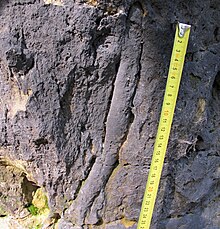| Ophiomorpha Temporal range:
| |
|---|---|
| Trace fossil classification | |
| Domain: | Eukaryota |
| Kingdom: | Animalia |
| Phylum: | Arthropoda |
| Subphylum: | Crustacea |
| Ichnogenus: | †Ophiomorpha |
| Ichnospecies | |
| |


Ophiomorpha is an ichnotaxon, usually interpreted as a burrow of an organism (specifically a crustacean[2]) living in the near-shore environment.[3] The burrow lining is more or less smooth on the inside, and densely to strongly mammalated or nodose on the outside, due to the packing of nodules for support of the burrow. Branching is irregular but Y-shaped where present.[4] It (particularly O. nodosa) is often considered part of the Skolithos ichnofacies,[5] where it has occurred (i.e. nearshore environments) since the early Permian,[6] though it (particularly O. rudis) has also occurred in deep water settings (Nereites ichnofacies) since the Late Jurassic, such as well-oxygenated turbidites.[7]
More generally Ophiomorpha and other crustacean-generated burrows first become prominent in the Jurassic.[8]
- ^ In near-shore environments, at least: Brenchley, Dr P. J.; Brenchley, P.; Harper, D. (1998-12-18). Palaeoecology. CRC Press. ISBN 978-0-412-43450-1.
- ^ McIlroy, D. (1 January 2004). The Application of Ichnology to Palaeoenvironmental and Stratigraphic Analysis. Geological Society of London. ISBN 978-1-86239-154-3.
- ^ Cite error: The named reference
boggs1995was invoked but never defined (see the help page). - ^ Cite error: The named reference
frey1978was invoked but never defined (see the help page). - ^ Cite error: The named reference
frey1984was invoked but never defined (see the help page). - ^ Brenchley, Dr P. J.; Brenchley, P.; Harper, D. (1998-12-18). Palaeoecology. CRC Press. ISBN 978-0-412-43450-1.
- ^ Tchoumatchenco, Platon; Uchman, Alfred (2001). "The oldest deep-sea Ophiomorpha and Scolicia and associated trace fossils from the Upper Jurassic–Lower Cretaceous deep-water turbidite deposits of SW Bulgaria". Palaeogeography, Palaeoclimatology, Palaeoecology. 169 (1–2): 85–99. Bibcode:2001PPP...169...85T. doi:10.1016/S0031-0182(01)00218-8.
- ^ Buatois, Luis A.; Mángano, M. Gabriela (11 August 2011). Ichnology: Organism-Substrate Interactions in Space and Time. Cambridge University Press. ISBN 978-1-139-50064-7.